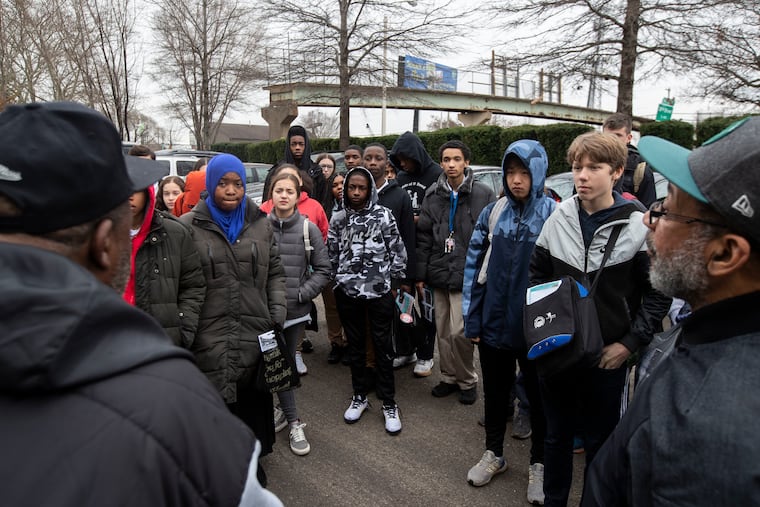What it was like to live across from Philadelphia’s biggest polluter
“When I was a little girl, it reminded me of the Wizard of Oz, with white smoke and all,” said Tammy Reeves, one of three residents who told eighth graders what life was like growing up in the shadow of the biggest crude oil refinery on the East Coast.

Charles Reeves, 59, came to a stop Friday along a bridge on Wharton Street in Philadelphia’s Grays Ferry neighborhood, and turned to a group of eighth graders following him. A stream of black tanker cars passing below rolled beneath dim, cloudy skies.
“You see that?” Reeves shouted over the din of traffic and the clank of the train. “That’s millions of dollars of oil coming through right there. And neighbors don’t see any of it. ... They made money off of us. They never cared about us. But we lived in the projects and couldn’t afford to move out.”
Reeves spoke during a tour for schoolchildren designed to teach them about growing up in the shadow of the biggest crude oil refinery on the East Coast, and also the environmental problems the area faces.
He was referring to the now shuttered Philadelphia Energy Solutions refinery that exploded and caught fire last summer. Reeves has prostate cancer he believes stems from living near the refinery his entire life.
The trains were exiting the property’s Point Breeze Refinery North Yard, bordering the Schuylkill River and home to the 1,300-acre complex’s first refinery, where crude oil operations started in the late 1800s. The area is widely contaminated with cancer-causing benzene and other substances.
The students from the Alcorn School — in Gray’s Ferry — and Germantown Friends, a few miles north, were part of a tour organized by the Penn Program in Environmental Humanities (PPEH) project. The program helps schoolchildren examine environmental issues.
Reeves, his wife, Tammy, and Melissa Toby represented the Tasker-Morris Neighbors Association at the tour.
“Every night, fire would shoot out of there,” Tammy Reeves said, pointing toward stacks rising from the refinery complex. She was referring to flaring, a process refinery operators used to burn off excess hydrocarbons.
“When I was a little girl, it reminded me of the Wizard of Oz, with white smoke and all,” she said. “It was scary. We would close our windows and doors.”
Many of the students in the area said they gave little thought to the refinery before the explosion.
Tiana Gray, 13, who attends the Alcorn school, said she was at a friend’s house in June 2019 when the refinery exploded.
“I heard and felt a loud boom in my ear,” Gray said. “The room shook. But it didn’t really scare me. I was more curious about what had happened."
Abdul Mohammed, 14, also of the Alcorn school, said no one really talked much about the refinery in the past.
“Now, I hope they shut it down for good,” he said.
Lorenzo Hayward, an 8th grade teacher at Alcorn, said learning about the refinery has been a revelation for the students.
“They weren’t even aware this was right in their backyard,” Hayward said.
In February, a U.S. Bankruptcy Court approved the sale of the shuttered property to Hilco Redevelopment Partners. Hilco, based in Chicago, agreed to pay $252 million for the refinery with plans to demolish it and build a mixed-use industrial park. It aims to close the sale by the end of May.
The property is widely contaminated and carved up into 11 sections, each of which has its own problems. Hilco must reach agreements with regulators, and a previous property owner, regarding plans to clean up the contamination.
Bethany Wiggin, director of the PPEH project, said the goal was to get students to experience not only the refinery itself, but also the impact it has had on generations of residents. As part of the program, she said, students were asked to imagine the future of the refinery and create art to express those visions.
After a walking tour of the Tasker Homes neighborhood, once known as the Tasker Housing Project, students boarded a bus that drove along the perimeter security fence of the refinery complex. The bus passed dozens of massive tanks, and students witnessed flaring from one stack. They heard that the refinery was the city’s biggest polluter when it was operating.
“It’s a lot larger than I thought it would be, " said Neelmany Robinson, 14, who attends Germantown Friends. “I feel like it’s really a lot of space taken up in the city just to process fossil fuel.”